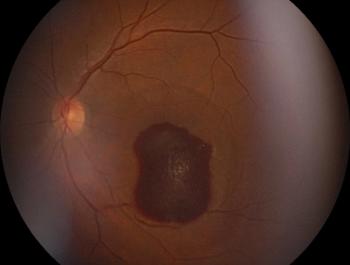
The neurology of glaucoma
The next time I see a patient with diabetic retinopathy who seems to be nonchalant or blasé regarding his condition, I’m going to say something along the lines of this: “Mr._______, this leaking of your blood vessels is going on elsewhere in your body, but your eyes just happen to be the only place we can see it without being invasive.”
The patchy areas of pallor within the optic nerve head of this normal-tension glaucoma patient may be indicative of microvascular damage elsewhere along the optic nerve. I’ve come up with something, which I think may actually be clever. The next time I see a patient with diabetic retinopathy who seems to be nonchalant or blasé regarding his condition, I’m going to say something along the lines of this: “Mr._______, this leaking of your blood vessels is going on elsewhere in your body, but your eyes just happen to be the only place we can see it without being invasive.”
OK, I’m pretty sure I’m not the first clinician to come up with a statement like that, but it does bring to the surface the notion that patients with diabetic retinopathy likely have other forms of diabetic vasculopathy going on in multiple organs. The total length of the vasculature of an average adult is over 50,000 miles. That’s long enough to wrap around the Earth more than twice (and certainly long enough for something to go wrong). On the other hand, the optic nerve is a mere 5 cm long before it reaches the optic chiasm. However, if you divide the optic nerve into its 1.2 million or so ganglion cells (and take into consideration the fact that those ganglion cells continue on through the optic tract before they synapse in the lateral geniculate nucleus), you’re left with a lot of room for trouble.
Optic nerve and the CNS
When we evaluate a glaucomatous optic nerve head, we may not be looking at the only part of that optic nerve that is damaged-we’re just looking at the only part we can see with a precorneal lens. Ganglion cell damage from glaucoma commonly exists elsewhere along the path from the globe to the occipital cortex,1,2 and the presence of this retrobulbar damage really points to glaucoma as being a neurological disease (rather than an “eye” disease). The semantics of glaucoma lend themselves seamlessly to this point: the optic nerve is simply part of the central nervous system. However, many of us tend to draw a passive distinction between “eye” and “brain.”
Several studies have shown damage at the level of the lateral geniculate nucleus in glaucoma patients.1,2 At least 1 study (using non-human experimental-glaucoma models) has shown changes in all 6 layers of the lateral geniculate nucleus after induction of ocular hypertension.3 This area of the brain happens to be the first place where retinal ganglion cells synapse-that’s a long way for a single ganglion cell to travel.
Identifying risk factors
So, does the presence of glaucomatous damage within the brain actually change how we think about glaucoma? Well, it might. As we continue to better understand the pathogenesis of glaucoma, we continue to identify new potential risk factors. Further along this line of thought, while it may not directly change how we treat glaucoma, understanding that cerebrovascular disease can lead to damage of the optic nerve may help explain why some glaucoma patients progress in spite of achieving a significant reduction in intraocular pressure. This may be especially true in the presence of normal tension glaucoma, with which cerebrovascular issues may be more commonplace.4 This would make sense because we tend to think of normal tension glaucoma as a disease of older persons.
I suppose this means that, in order to be good at treating glaucoma, one has to remain cognizant of the neurology of the visual system and the potential risk factors throughout. This comes as somewhat unwelcome news to me as I reflect back on a day during my residency when one of my patients whom I had sent for an urgent neuro-ophthalmic consult came back with a diagnosis of hyperopia.
So, concurrent with the advances in our understanding of glaucoma has been an enhanced understanding of the entire optic nerve as a highly plastic continuum of communication not only by means of axonal transport but also by means of chemotactic and neurotrophic factors throughout. Furthermore, thinking about the nerve fibers we evaluate at the level of the optic nerve head as being the same nerve fibers that synapse at the lateral geniculate nucleus should, at the very least, guide us in the direction of thinking about glaucoma as a true neurological disease and not just as a disease of the optic nerve head.ODT
References:
1. Gupta N, Greenberg G, de Tilly LN, et al. Atrophy of the lateral geniculate nucleus in human glaucoma detected by magnetic resonance imaging. Br J Ophthalmol. 2009 Jan;93(1):56-60.
2. Chen Z, Wang J, Lin F, et al. Correlation between lateral geniculate nucleus atrophy and damage to the optic disc in glaucoma. J Neuroradiol. 2013 Oct;40(4):281-7.
3. Dai Y1, Sun X, Yu X, et al. Astrocytic responses in the lateral geniculate nucleus of monkeys with experimental glaucoma. Vet Ophthalmol. 2012 Jan;15(1):23-30.
4. Harris A1, Siesky B, Wirostko B. Cerebral blood flow in glaucoma patients. J
Glaucoma. 2013 Jun-Jul;22 Suppl 5:S46-8.
Newsletter
Want more insights like this? Subscribe to Optometry Times and get clinical pearls and practice tips delivered straight to your inbox.




















































.png)


